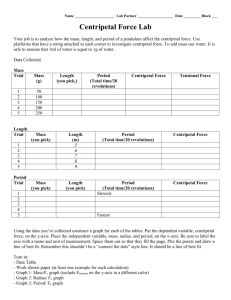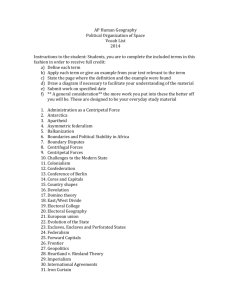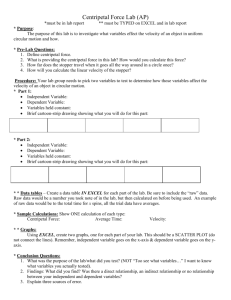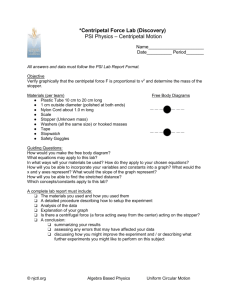Physics 121
advertisement
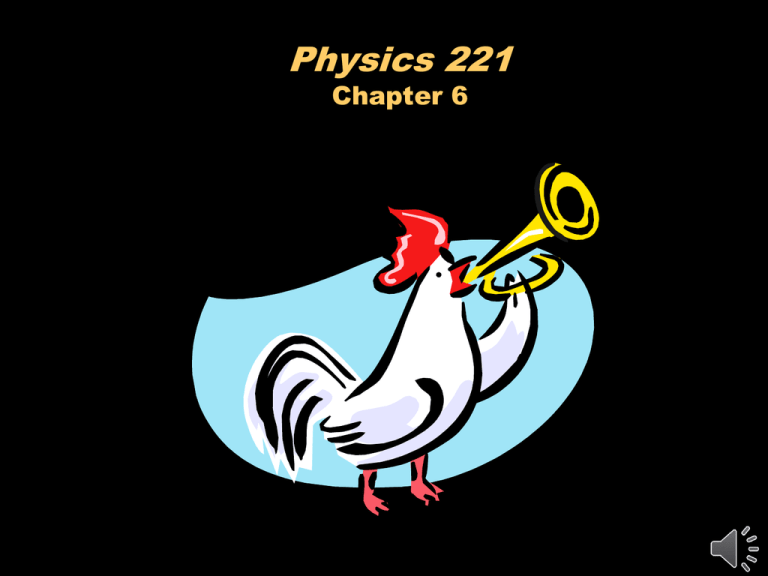
Physics 221 Chapter 6 Problem 1 . . . Round and round • A red car goes counterclockwise around a track at a constant speed (see figure) P • A. The car is accelerating and Q shows the direction of the force on it • B. The car is accelerating and P shows the direction of the force on it Q • C. The car is not accelerating • D. The car is accelerating but there is no force acting on it. Solution 1 . . . Round and round • A red car goes counterclockwise around a track at a constant speed (see figure) P • A. The car is accelerating and Q shows the direction of the force on it. • Centripetal Force changes the direction • Centripetal Force does not change speed • Centripetal Force points toward the center Q Problem 2 . . . Equation for C.F. • The correct equation for centripetal force is • A. F = mv • B. F = mvr • C. F = mv / r • D. F = mv2 / r Solution 2 . . . Equation for C.F. • The correct equation for centripetal force is F = mv2 / r Problem 3 . . . Stoned and strung • Dennis the menace ties a 250 g rock to a 160 cm. string and whirls it above his head. The string will break if the tension exceeds 90 N. What minimum speed will endanger the windshield on his neighbor’s car? Solution 3 . . . Dennis the Menace • Centripetal Force is F = mv2 / r • 90 = (0.25)(v2 / 1.6 ) • v = 24 m/s Problem 4 . . . Slippery when wet! • A car exits on a ramp (unbanked) of radius 20 m. The coefficient of friction is 0.6. The maximum speed before slipping starts is most nearly • • • • A. B. C. D. 10 m/s 20 m/s 40 m/s 120 m/s Solution 4 . . . Slippery when wet! • Force of Friction = Centripetal force • (0.6)(m)(g) = (m)(v2) / r • v = 11 m/s Problem 5 . . . Spaced out! • Residents in a colony in outer space live in a cylindrical spaceship that has a diameter of 90 m and its speed at the rim is 15 m/s. The simulated “g” felt by the occupants is most nearly • • • • A. B. C. D. 0.5 g 1.0 g 2.0 g 5g Solution 5 . . . Spaced out! • (m)(v2) / r = m “g” • • • • • “g” = v2 / r “g” = (15)(15)/45 “g” = 5 m/s2 “g” = 0.5 g Correct answer is A. Satellites • Many LEO (Low Earth Orbit) satellites are fairly close to the Earth. There is substantial “g” out there. Yet people “feel” weightless! This has to do with “free-fall” like when you are in an elevator and it accelerates down. • Problem 8: How much would a 120 lb woman “feel” she weighs in an elevator decelerating at 2 m/s2 ? Satellites • • • • • • Solution8: F = ma mg - T = ma T = mg - ma T = 12 x 10 - 12 x 2 T = 120 - 24 T = 96 lbs. T a mg • Note: Satellites are in “free-fall” so the occupants feel weightless! Air Drag • Free-fall acceleration is g= 9.8 m/s2. However, if air resistance is taken into account then the acceleration keeps decreasing as the object’s speed keeps increasing. This is because the resistive force of air drag increases as the speed increases. When the resistive force becomes equal to the force of gravity (weight) the object attains a constant speed. This final constant speed is called Terminal Velocity. Terminal Velocity What does “drag” depend on? Air Resistance (drag) is generally proportional to the square of the speed R = Cv2 R = ½ D A v2 R = resistive force D = Drag coefficient (0.5 to 2) = density of air A = cross-sectional area Generally in a liquid, the resistance is proportional to the speed R = - bv That’s all Folks!
